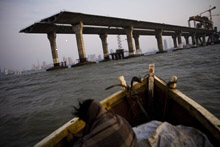
Typical street scene in Santa Ana, El Salvador. (Photo: iStock)
IMF Survey: India: Rapid Growth with Promising Medium-term Prospects
January 5, 2011
- At 8¾ percent, India GDP growth for 2010/11 projected to be above trend
- IMF backs attempts to bring down elevated inflation
- Subsidy reforms needed to meet fiscal consolidation targets, says IMF
With robust growth spurring elevated levels of inflation, India should speed up its return to pre-crisis monetary and fiscal policies to keep the economy in check, suggests the IMF in its annual assessment of one of the world’s fastest growing economies.

Bridge under construction in Mumbai. Investment in infrastructure is supporting growth in India (photo: Adam Ferguson/Corbis)
ECONOMIC HEALTH CHECK
In its report on the Indian economy—known as the Article IV consultation—IMF economists said they expect the South Asian country to grow above trend this year, with high levels of growth continuing over the medium term
“We expect real GDP to grow 8¾ percent in 2010/11, with robust growth supported by high investment in infrastructure and productivity gains,” said the IMF’s mission chief for India, Masahiko Takeda.
India weathered the recent global financial crisis well, and since mid-2009 domestic demand has powered a vigorous recovery. The country’s growth rate remains among the strongest in the world.
Toward a more normal policy stance
In its report, the IMF backed the authorities’ policy of exiting from the stimulus implemented in the past two years. But this exit strategy remains incomplete.
Given the high level of government debt, existing strong domestic demand, and large capital inflows, IMF economists said that fiscal policy is the preferred method for tightening.
In their assessment, the report’s authors welcomed the authorities’ renewed commitment to fiscal consolidation: the government has laid out an ambitious roadmap to reduce public debt and deficits, and high growth is expected to contribute toward this goal as well.
The IMF also supported the objective to raise public investment, especially in infrastructure, and to improve social outcomes. The challenge will be to make savings elsewhere to meet these objectives while remaining on the consolidation path.
Carrying through with consolidation
With tax reforms designed to be revenue neutral, IMF economists see the need for subsidy reforms—particularly a liberalization of diesel and fertilizer prices—coupled with more efficient spending.
“A commendable first step in fuel price liberalization has been taken and promising tax reforms are in the works,” notes the report.
Strengthening the budget framework will be important to minimize risks to fiscal consolidation, while the government’s strong revenue position this year presents an opportunity to reconstitute fiscal space faster and reduce the risk of overheating, say the economists.
Tackling inflation
The IMF report also recommends further tightening monetary policy to meet the authorities’ inflation objectives and anchor inflation expectations.
With little or no spare capacity in the economy, coupled with the threat of rising food prices, inflation is currently elevated in the range of 8½—10½ percent. Inflation is expected to come down slowly as last year’s high food prices caused by poor rainfall drop out of the inflation calculation, but underlying price pressures are still strong, say IMF economists.
Over the last year, the authorities have raised policy rates and the cash reserve requirement, but further increases in policy rates would help bring real short-term interest rates in line with historical norms, and help contain inflation, they add.
A more rapid withdrawal of fiscal stimulus at an earlier stage would have helped contain demand, “but in its absence, a greater burden falls on monetary policy to cool the economy and counter the perception that inflation has shifted to a higher level, “ said Takeda.
Capital inflows fund current account deficit
The current account deficit is projected to reach 3.3 percent of GDP in 2010/11 and 3.5 percent next year, say the economists in their report. The deficit has so far been financed mainly by foreign direct investment and equity inflows, but the authorities need to keep an eye on the level of the current account deficit.
As the deficit rises, so does the potential impact of a sudden stop or reversal of capital flows. Another risk is that the scale of the inflows could exceed India’s capacity to absorb them.
In this event, IMF economists suggest that exchange rate appreciation should remain the first line of defense. If appreciation becomes too large, intervention in the foreign exchange market or macroprudential measures could also be taken.
Over time, deepening the corporate bond market, increasing the supply of shares, and further liberalizing foreign direct investment would increase the country’s capacity to absorb capital from abroad.
Meeting infrastructure targets
Infrastructure investment has grown rapidly in India over the past few years, and the authorities plan to double the money spent on this sector from $500 billion in the five years ending 2011/12 to $1 trillion in the following half a decade. Private participation is expected to account for half of the total.
Increased infrastructure spending should sustain higher growth, but there are several obstacles to achieving set targets. These include availability of financing, land acquisition, multiple clearances, capacity constraints, and governance issues along with various sector-specific concerns.
The IMF believes structural reforms in these areas are needed to lower the cost of infrastructure, encourage private investment, and allow more efficient use of public resources.


